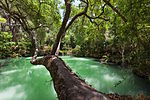Enterprise, Florida

Enterprise is an unincorporated community in Volusia County, in the U.S. state of Florida, and its former county seat. Situated on the northern shore of Lake Monroe, it is flanked by the cities of DeBary and Deltona. Enterprise was once the head of navigation on the St. Johns River and at various times, the county seat for three different counties: Mosquito, which was renamed as Orange; and lastly, for Volusia, which was formed from part of Orange County.In 2006 Volusia County government approved a historic overlay which designates Enterprise as an "area of special concern" as a historic village. This establishes a defined historic district within the community and ensures that any development must follow strict guidelines.
Excerpt from the Wikipedia article Enterprise, Florida (License: CC BY-SA 3.0, Authors, Images).Enterprise, Florida
Main Street,
Geographical coordinates (GPS) Address Nearby Places Show on map
Geographical coordinates (GPS)
| Latitude | Longitude |
|---|---|
| N 28.869166666667 ° | E -81.266666666667 ° |
Address
Main Street 96
32725
Florida, United States
Open on Google Maps









